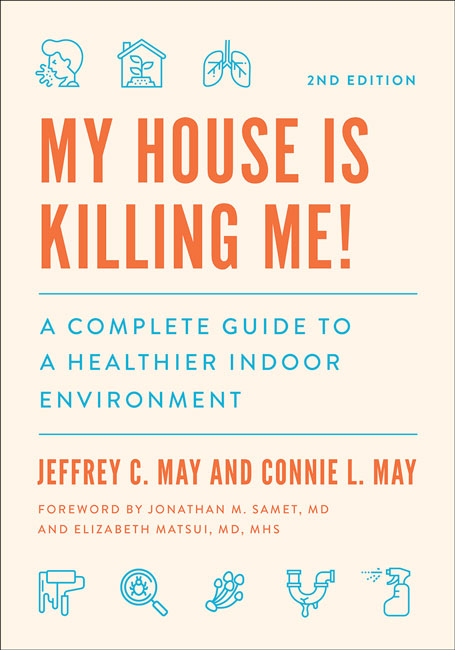Interview: Jeffrey May, author, building consultant and air quality expert
 Air Quality News talks to Jeffrey May, building consultant, indoor air quality expert and co-author of My House is Killing Me!
Air Quality News talks to Jeffrey May, building consultant, indoor air quality expert and co-author of My House is Killing Me!
What led you to write this book?
I have a lot of allergy problems and with my research, I started to see the connection between what I was feeling, the dust samples I was collecting and what was going on in the air.
If we could see what is in the air, it would be like looking into a pond of murky water, but because we can’t see it we don’t know what’s happening.
What are the common misconceptions when it comes to indoor air pollution?
I think discussions around air pollution tend to focus on outdoor air quality, but according to the US Environment Protection Agency, indoor air pollution is about five times worse than outdoor air pollution and there’s really no one to blame but yourself.
You might not know what the problem is but at the end of the day, you’re in charge of your indoor environment.
What are the most common sources of indoor air pollution?
Dust is the biggest evil, I think many people just accept that there is dust in their home and they don’t really think too much about it, but dust is basically where all the evil hides and I think many people are allergic to it but they just don’t know about it.
Another major source is our indoor heating, particularly wood-burning stoves. People use them as an alternative way of heating or just because they like the way they look, but we’ve had a number of clients with terrible asthma because their neighbours have wood-burning stoves.
What are your top tips for improving indoor air quality?
It’s simple, you should use a vacuum cleaner. I know bagless vacuum cleaners are really popular now, but when you use these and you dump the waste in your bin, a lot of that dust is then spreading into the air that we breathe.
Your book focuses on homes but what about other residential properties like schools or rented properties?
Schools have the same kinds of problems as homes really. There are a lot of maintenance issues, but one of the biggest problems is that most schools have unit ventilators.
These are just cooling or heating units, but these things can get full of mould, and then as they blow air through the mould it circulates through the building.
With rental properties, one of the biggest problems is carpeting, every allergen that’s ever been present in a rental property is going to be present in the carpet. We’ve had a lot of clients move into places and they can’t breathe because of what’s in the carpet so I mean if there was advice for people I would say get rid of the carpet if possible just have solid flooring.
But I think one of the big problems that we face in terms of indoor air pollution is the fact that not everybody has allergies and of those who do, only a small percentage of people are really affected.
My House is Killing Me! is available to buy here.

















There is very little evidence about closed fronted wood burners causing indoor air pollution. A recent article in the Guardian tried to highlight wood burners as a cause for indoor particulate matter, but the research was carried out on 17 appliances, and other information regarding type of fuel / type of appliance / moisture content of fuel / way the appliance was used was not made public by the Guardian. This is hardly therefore a concise bit of scientific research.
Additionally, wood burners affecting neighbouring residents has also been bought into question, particularly with modern appliances that have been designed within the Eco Design restraints, and using correct moisture content fuel. The studies carried out by UCL were in fact based on false estimates of how much timber is burned every year.
Further research carried out by the University of Leeds not only outlines how difficult it is to single out particulate matter from wood burners over that caused by open fires, bonfires, barbecues and even out of control forest / peat fires.
I have read preposterous arguments that say because it takes years to grow a tree that is ready to be felled and burned, then the CO2 emitted by a wood burner is exponentially big, and that it is better to use a gas appliance. What this argument does not take into account is:
The gas has been a carbon lockup for hundreds of millions of years, whereas trees lockup carbon within decades.
The more timber that is required, the more that is planted creating a virtuous circle of sustainable arboculture. Additionally , for every tree that is cut down, two or three are usually put in its place. These are then thinned as required, and the weaker trees can then be used for firewood or timber for the construction industry.
A wood burner itself has a very small carbon footprint. Almost all parts are 100 percent recyclable, and their service life can be up to 25 years with very few replacement parts ever being required.
The solid fuel industry is working very hard to further reduce all emissions emitted by stoves, and stamping on the industry all but wiping it out will prevent important research to continue in order to do this. In comparison to the likes of the car industry, it is a cottage industry.
Finally, in a world that is relying more and more on electricity, it does become a very important source of secondary heating. When the beast from the East hit us back in February 2018 we had a 16 hour power failure – without our wood burner to be there keeping my family and I warm (and to be able to cook with and make hot drinks) we would have been in a lot of trouble!
So to conclude, I agree – research and hard work to make wood burners cleaner burning is required – but rather than just tarnishing all kinds of biomass fires with the same brush – please let the solid fuel industry do their job which is important, and a lifesaver for many for heat and good mental health.